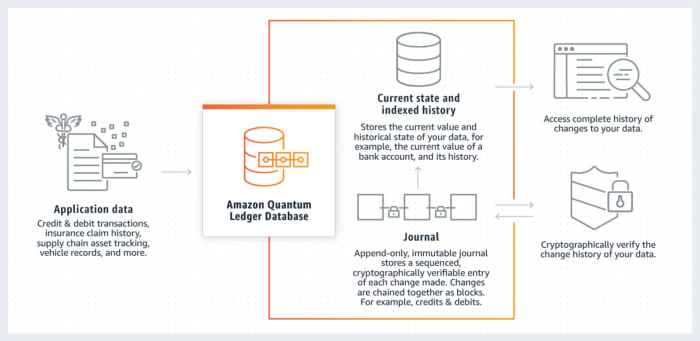I have been working with a US client to build a first-of-its-kind application to manage your consent to share your data amongst healthcare providers in your state. The project falls within HIPAA, so we need to meet all the HIPAA compliance requirements, including having a full history of the user data. To meet that audit requirement we used DynamoDB Streams and Lambda to get the change history out of the main transactional table.
However, we also considered switching from DynamoDB to QLDB. But ultimately we decided that it’s not yet ready for our use case yet. Big thanks to Matt Lewis for sharing their experience of working with QLDB at DVLA.
For anyone who’s considering QLDB for their project, here are the factors that lead to our decision.
The Good
- You get audit history out of the box with the
Historyfunction. e.g.Select * From History(tableName, startDate?, endDate?) WHERE metadata.id = ... - It supports more flexible queries than DynamoDB, you’re not limited by Hash + Range key. And there is no need for managing lots of composite keys and secondary indices to support querying on different fields.
- It has built-in support for transactions.
- It supports indices for improving read performance for attribute lookups.
- It’s completely schemaless (yup, don’t even need to specify a primary key).
- It supports nested fields.
- It’s pay-as-you-go, no need to pay for server uptime, yay!
- It uses IAM for authentication and authorization, don’t need to deal with VPCs.
- Its query performance (average ~30ms) is good, if not on par with DynamoDB.
- It has built-in support for optimistic concurrency control. For example, if a read was interrupted by another write, then the Ledger rejects the read and the app has to retry.
- There is no “hard” drop table. Dropped tables are simply marked as “inactive” and can be restored with
UNDROP TABLE. - You can stream data changes out to Kinesis in order to popular other read models – e.g. to ElasticSearch to support search features.
The Bad
- Lots of Partiql operations are not yet supported yet, but most importantly..
- No support for
Order By, so we can’t implement some of the required sorting in the app - No support for
LIMIT, so can’t implement pagination.
- No support for
- History queries require the document id, which you don’t know AFTER you run
INSERT INTO. Which makes queries histories a little awkward, a workaround for this (thanks to Matt Lewis for this tip!) is to capture it after the insert and then runUPDATEto add the id to the document. Fortunately, this can be done atomically in a transaction. - No support for conditional checks. Instead, you have to do a read to check if the document already exists, and decide whether to add the document. Fortunately, this can also be done, and the optimistic concurrency control ensures that a race condition won’t occur and cause you to add the same document twice.
- You can only have 5 indices per table.
- Indices can only be created when the table is empty.
- Unknown performance at scale without indices.
- Long cold start (the client library needs to init socket pool) time. During testing, this took around 300ms on average.
- No CloudFormation support for table and indices.
- There’s no support for KMS CMKs for server-side encryption, only QLDB managed KMS keys.
- IAM permission is not granular, it’s just
qldb:sendCommand. - While you can export ION documents to S3, there is no way to restore them right now.
- There is no direct integration with AppSync. But this 2-part blog post shows you how to build a reusable Lambda resolver that can make integrating AppSync with QLDB relatively straight-forward.
Although we decided not to go with QLDB for now, it is a very exciting piece of technology that we would love to use in the future. For now, some of these limitations are showstoppers for us. And while it makes some things easier (e.g. implementing audit history) it makes other things more difficult (e.g. implementing conditional checks, backup and restore, and integrating with our AppSync API). All and all, we don’t feel there would be any net gain in terms of development effort and velocity.
Hi, my name is Yan Cui. I’m an AWS Serverless Hero and the author of Production-Ready Serverless. I specialise in rapidly transitioning teams to serverless and building production-ready services on AWS.
Are you struggling with serverless or need guidance on best practices? Do you want someone to review your architecture and help you avoid costly mistakes down the line? Whatever the case, I’m here to help.
You can contact me via Email, Twitter and LinkedIn.
The post Why we didn’t choose QLDB for a healthcare app appeared first on theburningmonk.com.




Top comments (0)